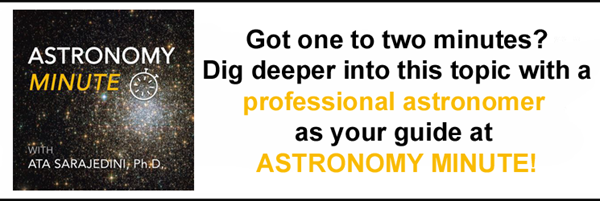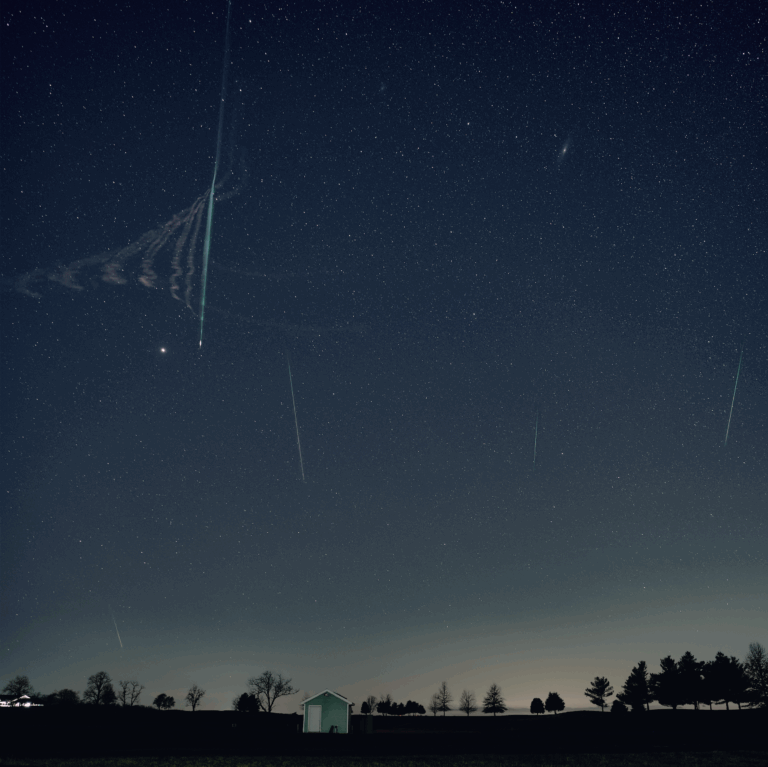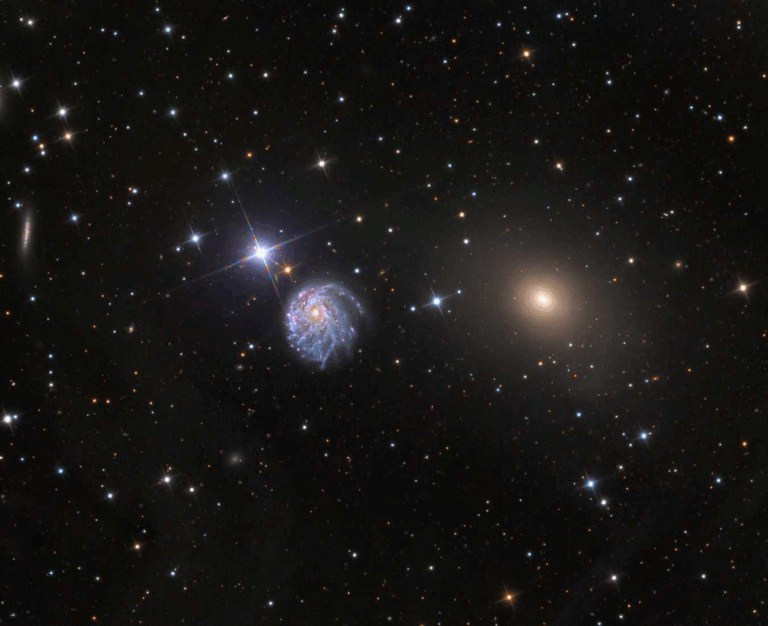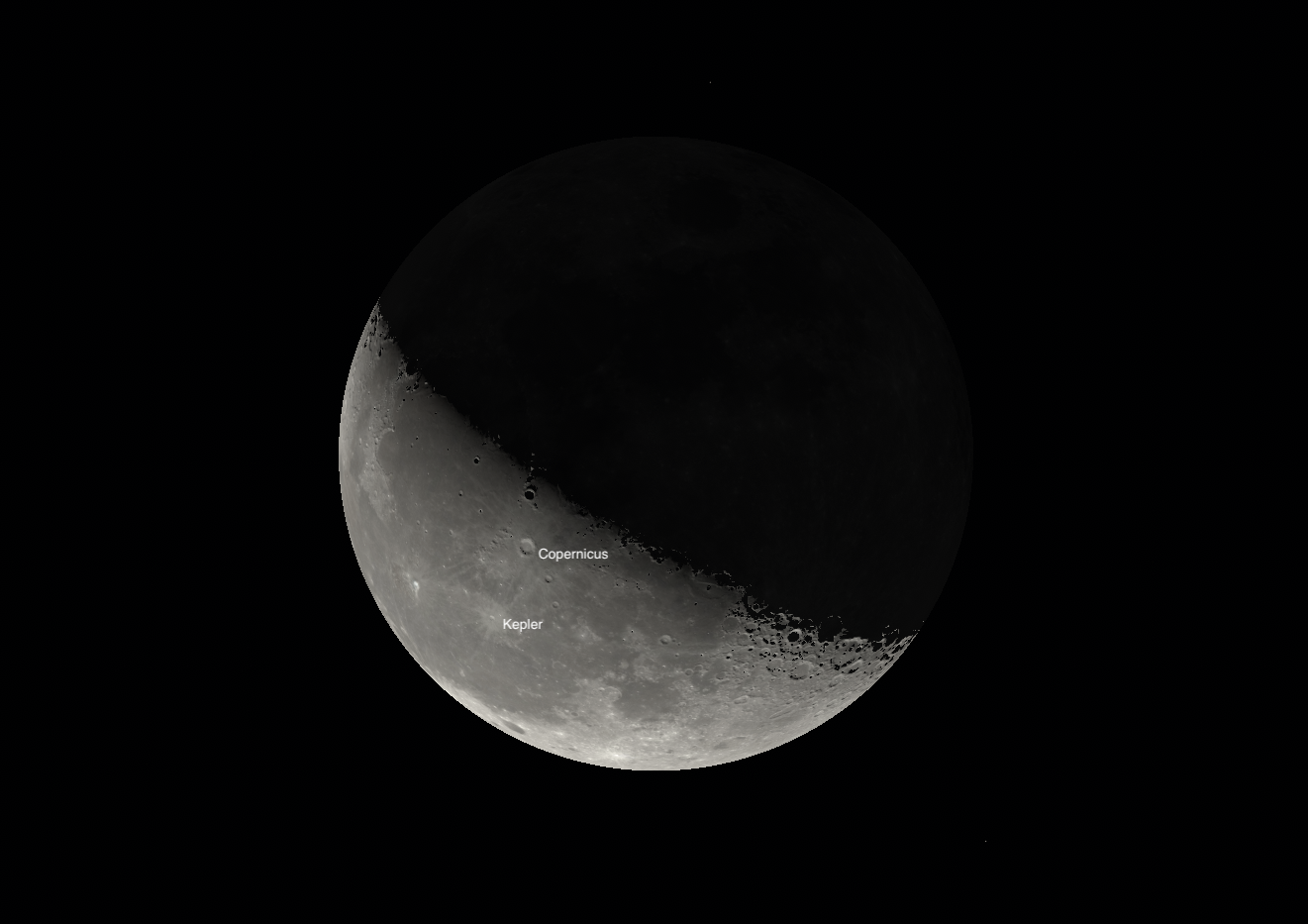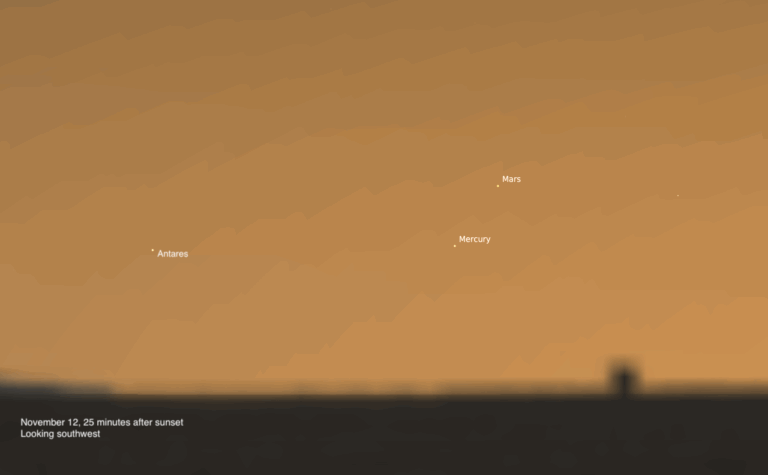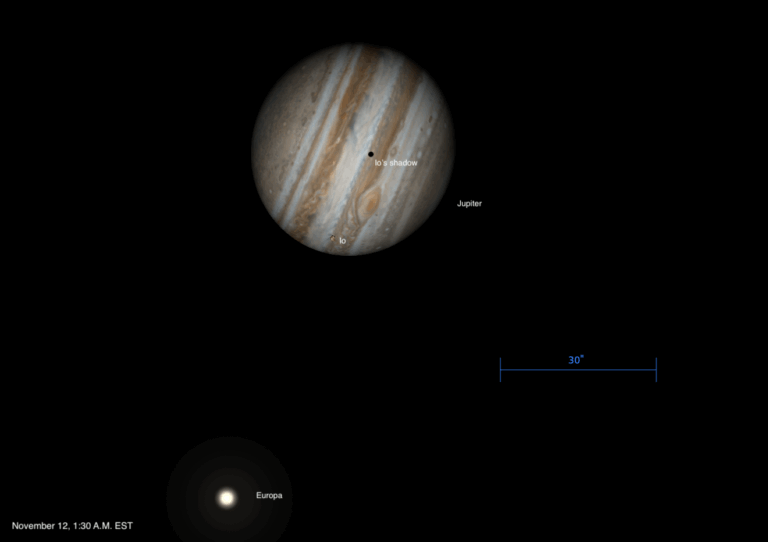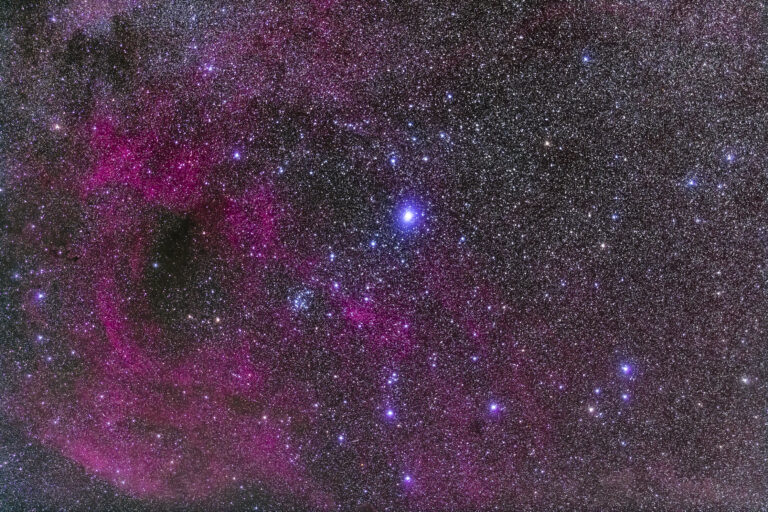Key Takeaways:
Friday, June 10
An old, familiar friend is now rising in the sky after sunset: Cygnus the Swan. This large, cross-shaped summertime constellation are easy to pick out. The Swan’s tail is marked by the bright star Deneb (magnitude 1.3), while his beak is the stunning double star Albireo (magnitude 3.1). Through a telescope, you can enjoy this pair’s contrasting colors of orange and blue. And if you live in a particularly dark location, step out on a moonless night and you’ll see the bright swath of the Milky Way running through the Swan’s body.
Cygnus has several deep-sky gems to enjoy, but tonight’s bright Moon will hinder your ability to enjoy most of them. That’s okay — we’ll be sure to revisit this area soon when there is no Moon in the sky and conditions for viewing faint objects are much better.
In the meantime, Deneb is also one point of three that make up the Summer Triangle asterism. Now entirely visible after dark, the other two points are Altair in Aquila and Vega in Lyra.
Sunrise: 5:31 A.M.
Sunset: 8:28 P.M.
Moonrise: 4:12 P.M.
Moonset: 2:50 A.M.
Moon Phase: Waxing gibbous (81%)
*Times for sunrise, sunset, moonrise, and moonset are given in local time from 40° N 90° W. The Moon’s illumination is given at 12 P.M. local time from the same location.
Saturday, June 11
Venus lies just south of Uranus in the early-morning sky today. Both lie in southeastern Aries the Ram, about 14° below magnitude 2 Hamal. Look east an hour before sunrise and you won’t be able to miss the bright beacon of Venus’ magnitude –3.9 glow, about 8° above the horizon. In binoculars or a small scope, Venus’ disk appears 13″ across and 81 percent lit. Roughly 1.6° north of Venus is the small, dim disk of Uranus. The ice giant spans just 3″ and shines a soft magnitude 5.8. Venus will pass due south of Uranus at 9 A.M. EDT.
As the twilight grows, those with a clear view of the horizon may catch Mercury, currently magnitude 0.9, rising around 4:30 A.M. local time. Take care not to scan the sky too close to sunrise with binoculars or a telescope — set an alarm for several minutes before the Sun peeks over the horizon from your location (not necessarily the time listed in this column; it may differ!) and stop using any astronomical equipment then.
Sunrise: 5:31 A.M.
Sunset: 8:29 P.M.
Moonrise: 5:27 P.M.
Moonset: 3:18 A.M.
Moon Phase: Waxing gibbous (89%)
Sunday, June 12
The Moon occults, or passes in front of, 2nd-magnitude Dschubba (Delta [δ] Scorpii) tonight, visible to observers in eastern Canada and the northeastern U.S. Our satellite rises before sunset; as the sky grows dark, you’ll find it in the southeast, among the stars of Scorpius and just 7° northwest of the bright red giant Antares.
Train binoculars on our satellite and watch as it covers or just slides past Dschubba. What you see depends on your location — those outside the region where the occultation is visible will see the Moon skim above the star instead. The timing of the occultation is also location dependent: In Massachusetts, the star disappears around 10:20 P.M. EDT and reappears just under an hour later. In other locations, this may happen earlier or later. You can check whether the event is visible from your location and what time the star will disappear and reappear on the International Occultation Timing Association’s website.
Sunrise: 5:31 A.M.
Sunset: 8:29 P.M.
Moonrise: 6:45 P.M.
Moonset: 3:50 A.M.
Moon Phase: Waxing gibbous (95%)
Monday, June 13
A bright Moon will hinder most deep-sky observing this evening, but double stars are still on the menu. After dark, look for the familiar W asterism of Cassiopeia, which sits right-side-up in the north early this evening.
Although not part of the W, Achird (Eta [η] Cassiopeiae) lies just below a line connecting Navi (Gamma [γ] Cas) and Shedar (Alpha [α] Cas), which form the left slant of the right half of the W. Achird sits about two-thirds of the way from Gamma to Alpha, and is a beautiful binary star system comprising a 3rd-magnitude, Sun-like yellow-white primary and a magnitude 7.5 orange-red secondary. The two are separated by 11″ — easily resolvable through a small scope. The stars orbit each other every 480 years with an average separation of nearly twice Pluto’s distance from the Sun.
Sunrise: 5:31 A.M.
Sunset: 8:30 P.M.
Moonrise: 8:04 P.M.
Moonset: 4:29 A.M.
Moon Phase: Waxing gibbous (99%)
Tuesday, June 14
Full Moon occurs today at 7:52 A.M. EDT. Almost exactly 12 hours later, at 7:12 P.M. EDT, the Moon reaches perigee, the closest point to Earth in its orbit. At that time, our satellite will sit 222,098 miles (357,432 kilometers) away. This means tonight’s Full Moon is also a Super Moon, a term applied when the Full phase occurs around the same time as Luna sits closest to Earth, making it appear larger and brighter than average.
Take some time to enjoy the June Full Moon — also called the Strawberry Moon — tonight. You may notice that its color is not pinkish, but instead more golden yellow than usual. It is for this reason that Astronomy columnist Bob Berman suggests we christen the June Full Moon the Honey Moon — what do you think?
This golden hue arises from the fact that the Moon stays close to the horizon, so its reflected light must travel a longer path through our atmosphere, which preferentially scatters away bluer light. And there’s something else going on with the Moon: Ever since First Quarter, it has been rising farther and farther south of due east each day. Tonight, the Moon rises at the farthest point southeast in this pattern; after today, it will begin moving northward, back toward due east. See if you can pick up this change over the next few nights.
Sunrise: 5:31 A.M.
Sunset: 8:30 P.M.
Moonrise: 9:20 P.M.
Moonset: 5:19 A.M.
Moon Phase: Full
Wednesday, June 15
There’s a two-hour window between sunset and moonrise tonight, which translates into about 30 to 60 minutes of good, dark-sky observing time. Use that time tonight to look for Corona Borealis the Northern Crown.
This small but bright constellation is bordered by Hercules, Boötes, and Serpens. According to Astronomy contributing editor Michael Bakich, Corona Borealis ranks 73rd in size out of the 88 constellations but is the 11th brightest. You’ll find it high overhead in the east about an hour and a half after sunset. The Crown’s brightest star, Alphecca (Alpha Coronae Borealis), shines at magnitude 2.2. Its beta star, magnitude 3.7 Nusukan, is the only other named star.
The “crown” itself is drawn from a u-shaped pattern of seven stars: In addition to Alpha and Beta, these comprise Iota (ι), Epsilon (ϵ), Delta, Gamma, and Theta (θ) Coronae Borealis. Tonight, the U is appears upside down above Hercules, and it’s about halfway along a line drawn between Zeta (ζ) Herculis and Izar in Boötes.
Sunrise: 5:31 A.M.
Sunset: 8:30 P.M.
Moonrise: 10:24 P.M.
Moonset: 6:20 A.M.
Moon Phase: Waning gibbous (98%)
Thursday, June 16
Mercury reaches greatest western elongation at 11 A.M. EDT, sitting 23° from the Sun. You can catch it within about an hour of sunrise, though you may want to wait until about 40 minutes before the Sun clears the horizon for the best views. By then, magnitude 0.5 Mercury has climbed nearly 5° above the eastern horizon.
The solar system’s smallest planet now forms a nice equilateral triangle with Venus — magnitude –3.9, 10° west of Mercury — and the Pleiades — 8.3° northwest of the planet. It’s a dramatic photo opportunity for wide-field imagers. Zoom in with a telescope to see that Mercury’s 8″-wide disk is just 36 percent lit.
Farther west, Mars (also magnitude 0.5) and Jupiter (magnitude –2.3) lie in Pisces. Saturn, nearly 41° west of Jupiter, sits in Capricornus, while the Moon lies even farther along the ecliptic in Sagittarius. In just over a week, the Moon and naked-eye planets will line up perfectly in order of distance from the Sun — an early-morning sight you absolutely won’t want to miss. Plus, binocular-magnitude Uranus and Neptune are nestled along the lineup as well, putting all seven planets in our morning sky: a relatively rare sight.
Sunrise: 5:31 A.M.
Sunset: 8:31 P.M.
Moonrise: 11:18 P.M.
Moonset: 7:33 A.M.
Moon Phase: Waning gibbous (93%)
Friday, June 17
Asteroid 10 Hygiea is making a tight turnaround in Virgo this month. Tonight, it’s come to a virtual standstill and over the next few days, this world will pivot from traveling northwest to moving east.
The Maiden is still some 40° above the southern horizon an hour after sunset and with no Moon yet in the sky, the time is ripe to net this main-belt body. First, find the constellation’s alpha star, magnitude 1 Spica — you can’t miss it! From there, it’s a short jaunt just over 8° southeast to 10th-magnitude Hygiea. A 4-inch scope or larger should capture the asteroid for viewing, and only a handful of field stars nearby are brighter.
Although classified as an asteroid, Hygiea is quite large — 270 miles (435 km) across — and its shape is nearly round. Despite its size, it remains fairly dim because its surface is dark and doesn’t reflect sunlight well. The brightest it gets is roughly magnitude 9 at perihelion, allowing observers to potentially spot it with binoculars.
Sunrise: 5:31 A.M.
Sunset: 8:31 P.M.
Moonrise: 11:59 P.M.
Moonset: 8:49 A.M.
Moon Phase: Waning gibbous (85%)






